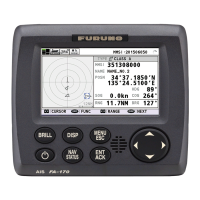1. MOUNTING
1-3
1.1.2 VHF antenna
Requirements for the antenna
Select a good quality antenna that meets the requirement listed below:
Installation location
The location of the mandatory AIS VHF-antenna should be carefully considered. Dig-
ital communication is more sensitive than analog/voice communication to interference
created by reflections in obstructions like masts and booms. It may be necessary to
relocate the VHF radiotelephone antenna to minimize interference effects.
To minimize interference effects, the following guidelines apply:
• The AIS VHF antenna should be placed in an elevated position that is as free as
possible with a minimum of 0.5 meters in the horizontal direction from constructions
made of conductive materials. The antenna should not be installed close to any
large vertical obstruction. The objective for the AIS VHF antenna is to see the hori-
zon freely through 360 degrees.
• The AIS VHF antenna should be installed safely away from interfering high-power
energy sources like radar and other transmitting radio antennas, preferably at least
3 meters away from and out of the transmitting beam.
• There should not be more than one antenna on the same plane. The AIS VHF an-
tenna should be mounted directly above or below the ship’s primary VHF radiotele-
phone antenna, with no horizontal separation and with a minimum of 2.8 meters
vertical separation. If it is located on the same plane as other antennas, the distance
apart should be at least 10 meters.
Cabling
• The cable should be kept as short as possible to minimize signal attenuation. Co-
axial cables equal to or better than RG10U/Y are recommended.
• All outdoor-installed connectors on coaxial cables should be fitted with preventive
isolation such as vulcanizing tape to protect against water penetration into the an-
tenna cable.
• Coaxial cables should be installed in separate signal cable channels/tubes and at
least 10 cm away from power supply cables. Crossing of cables should be done at
right angles (90°). The minimum bend radius of the coaxial cable should be 5 times
the cable's outer diameter.
• Frequency range: 155 to 164 MHz
• Impedance: 50 ohms
• Polarization: Vertical
• Handling power: 30W
• VSWR: Less than 1.5 (157 to 159 MHz)
• Quality: Able to withstand the marine environ-
ment

